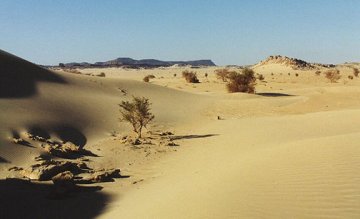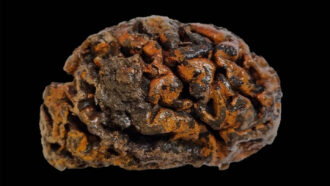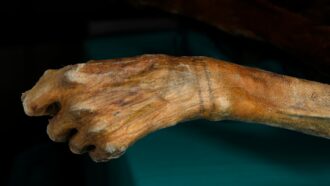Sahara cemetery
Archaeologists uncover the remains of a Stone Age settlement in the Sahara desert.
By Emily Sohn
Paleontologist Paul Sereno and his team were looking for dinosaur bones in West Africa in 2000 when they stumbled upon something unexpected.
 |
|
A desert scene in the West African country of Niger.
|
| Photo by Galen Frysinger |
First, a member of the crew spotted the fossilized armor plates of a crocodile. It was sticking out of the sandy desert. Soon after that, someone else found a foot-long shard of an ancient cow skull. Then came the whopper.
“Look, it’s human!” a team member shouted. “Part of the skull!”
Everyone was surprised.
“A stone tool surfaced, and we realized we were sampling the skeletons and tools of ancient human occupants of the Sahara and the animals that filled their world,” wrote Sereno. He chronicled the find in his log about the expedition. It took place in the country of Niger (pronounced Nee-ZHAIR).
Further exploration revealed what appeared to be a massive cemetery. It lay next to an ancient lakebed. Human skeletons lay scattered in the sand. Many were intact and undisturbed.
Among the bodies lay animal and fish bones, arrowheads, harpoons, green jasper tools, jewelry and other artifacts. All were between 5,000 and 9,000 years old. They dated to a period that marked the beginning of the Holocene epoch in Earth’s history.
The team returned to the site to dig for human remains in 2003. They went back again in the fall of 2005. With more than 170 skeletons unearthed so far, the cemetery is one of the richest and best-preserved sources of Holocene remains ever discovered in the region.
 |
|
A map of Niger, a landlocked country in West Africa. Two-thirds of the country is desert.
|
| CIA |
“It’s enormous,” says Elena Garcea. She’s an archaeologist from Cassino University in Italy, who is also working on the site. “I’ve never seen such a big cemetery from that early of a period anywhere in North Africa or the Nile Valley or West Africa.”
Because the graveyard promises to give insight into a long list of mysteries, the researchers nicknamed it Enigma. Garcea says that the team’s findings are already shaking up theories about human history. They are also revealing new details about what life was like for people in West Africa during the early Holocene.
Changing times
The jackpot of information is especially exciting for archaeologists. That’s because our ancestors were going through a lot of changes at the time. Around 10,000 years ago in the Middle East, Sereno says, people started making pottery. They also were grinding and polishing stones instead of just flaking them into tools. They even began raising animals and tending crops.
These advances were major steps toward modern civilization. And scientists have long assumed that people had to take these steps before they could give up their nomadic life and settle down in communities supported by agriculture.
 |
|
A present-day village in Niger.
|
| Photo by Galen Frysinger |
Enigma suggests that people in Africa took a different path. Some of the first ceramic bowls on record appear in the region, Sereno says, and people started grinding stones early, too, just as they did in the Middle East.
Fossilized animal bones, however, show that the people who buried their dead at Enigma and lived along the nearby lake didn’t start raising cattle until 5,000 years ago, Sereno says. And they didn’t start to sow crops until 3,000 years ago.
An enormous number of catfish bones at the site show that the people were primarily fishers. They also probably gathered plants for food. That’s interesting because although the Sahara is a desert now, it appears that the region was once lush and wet.
Interesting stories
The skeletons and artifacts found at Enigma have plenty of other interesting stories to tell. One skeleton was 6 feet 4 inches tall, Sereno says. A male and female skeleton lying together reveal a double burial. Jewelry and other objects lay alongside some of the bodies.
And a large number of the excavated skeletons were of young people, says Jeff Stivers, who worked as a field technician on the 2003 and 2005 expeditions.
“This is obviously a small sample from a larger population, and we’ll have a better idea later, but people were dying at very young ages,” Stivers says. “There were no modern medicines or a lot of other things we take for granted today that sustain people’s lives.”
 |
|
A modern-day caravan setting off across the Sahara desert.
|
| Photo by Galen Frysinger |
Further analyses of bones will help researchers learn more about the types of activities people did, what they ate, what kinds of diseases they had, how old they were when they died, and more.
Scientists are also hoping to extract fragments of DNA that might reveal relationships between these ancient populations and groups of people still living in Africa today.
For now, archaeologists are hustling to collect as much information as possible. Enigma is a fragile site. The harsh desert sun and biting winds are eroding what’s left of the remains. And pillaging, or theft of artifacts, is always a fear.
“It’s a race against time,” Sereno says. “There are only a handful of sites like this left today. We want to make sure we excavate the majority of it carefully before people come to know where it is.”
 |
|
Niger’s flag has three equal, horizontal bands of orange, white, and green, with a small orange disk in the middle band representing the sun.
|
| CIA |
Going Deeper:







